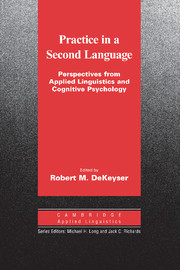Book contents
- Frontmatter
- Contents
- List of contributors
- Series editors' preface
- Introduction: Situating the concept of practice
- I: FOUNDATIONS
- II: INSTITUTIONAL CONTEXTS
- III: INDIVIDUAL DIFFERENCES
- Chapter 9 Age-related differences and second language learning practice
- Chapter 10 Aptitudes, abilities, contexts, and practice
- Conclusion: The future of practice
- Glossary
- Index
- References
Chapter 9 - Age-related differences and second language learning practice
Published online by Cambridge University Press: 27 January 2010
- Frontmatter
- Contents
- List of contributors
- Series editors' preface
- Introduction: Situating the concept of practice
- I: FOUNDATIONS
- II: INSTITUTIONAL CONTEXTS
- III: INDIVIDUAL DIFFERENCES
- Chapter 9 Age-related differences and second language learning practice
- Chapter 10 Aptitudes, abilities, contexts, and practice
- Conclusion: The future of practice
- Glossary
- Index
- References
Summary
Introduction
The aim of this chapter is to bring together information about age-related differences from the fields of psychology and second language (L2) acquisition research that may allow the identification of relevant characteristics of L2 learning practice activities appropriate to various ages.
It is assumed here that practice, understood in the sense of “engaging in an activity with the goal of becoming better at it” (DeKeyser, 1998, p. 50), has an important role to play in language learning and hence in the language classroom. This definition is sufficiently neutral to encompass the different views that assign various roles to practice in language acquisition: from item learning and the improvement of fluency (e.g., Ellis, 1997) to gradually bridging the gap between explicit knowledge and use (see DeKeyser, 2003). Further, research seems to provide increasing evidence of the importance of skill-specific practice; for example, input practice seems necessary in order to build comprehension skills and output practice to build production skills (DeKeyser & Sokalski, 1996; DeKeyser, 1997; Salaberry, 1997). In sum, practice may not make perfect (Ellis & Laporte, 1997), but it does make better.
It is also assumed here that good language learning practice activities present an adequate balance between demands and support. An example of the importance of demands on learners is provided by the lack of accuracy observed in learners exposed only to comprehensible input, whose language learning resources are not “stretched” enough by the need to produce accurate L2 output (Swain, 1985, 1995).
- Type
- Chapter
- Information
- Practice in a Second LanguagePerspectives from Applied Linguistics and Cognitive Psychology, pp. 229 - 255Publisher: Cambridge University PressPrint publication year: 2007
References
- 21
- Cited by



